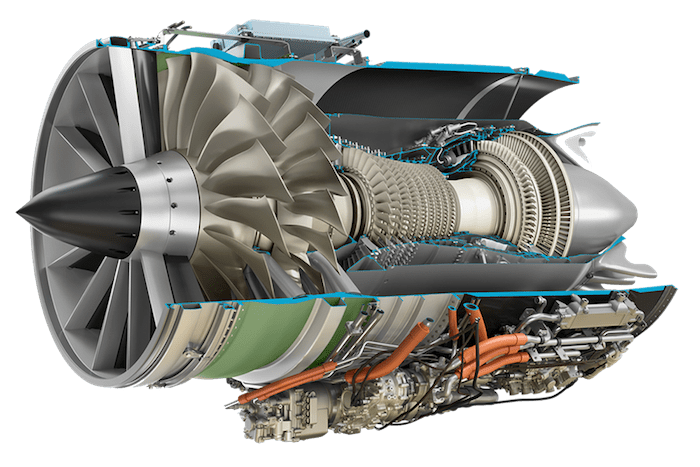
GE Aviation’s Affinity engine for the Aerion AS2. Image courtesy of Aerion
GE Aviation and Honeywell Aerospace confirmed plans to supply a new engine and integrated avionics cockpit for Aerion’s AS2 supersonic business jet at the National Business Aviation Association’s (NBAA) 2018 annual conference and exhibition this week.
Aerion first unveiled its $120 million supersonic business jet at NBAA’s 2015 conference, where it confirmed FlexJet as the aircraft’s launch partner. Now with its key suppliers confirmed, Aerion is moving closer to making supersonic business jet travel a reality. The company outlined a goal of achieving product design review by June 2020, leading to a first flight of the AS2 in June 2023.
The manufacturer has completed initial design work on its “Affinity” engine for the AS2, GE Aviation Head of Business and General Aviation Brad Mottier told reporters during a joint press conference with Aerion, Honeywell and Lockheed Martin Skunkworks. Mottier said the engine will be a twin-shaft, twin-fan turbofan capable of flying faster than the speed of sound over water while flying at subsonic speeds over land.
“This isn’t a case of just taking an engine and putting it in a nacelle pod on the side of an airplane or under a wing,” said Mottier. “There’s two fans on this engine with the highest bypass ratio ever for any supersonic engine.”
GE is designing the engine to support an altitude ceiling of 60,000 feet for the AS2 and will design a next-generation full authority digital engine control (FADEC) system for the aircraft as well. The engine core will be based on technology derived from GE’s current commercial airline engine family, such as the GE-9X, which will power the 777X when it enters into service in 2020.
Affinity will not feature any afterburners, a design feature of the Concorde — the aviation industry’s previous commercial supersonic jet — that Mottier said GE did not want to bring to the AS2. It will, however, feature a special non-augmented supersonic exhaust system to help lower the noise generated by AS2 when taking off.

Aerion AS2. Image courtesy of Aerion
Aerion CEO Tom Vice said the company has been working with GE Aviation, Honeywell Aerospace and Lockheed Martin’s Skunkworks to establish a risk assessment for the program. During a two-day design review in September, they determined that all of the technology required to make civilian supersonic flight a reality by the mid-2020s is available today.
Eventually Vice wants to include a new design feature into the AS2 related to the control of aircraft at Mach speeds.
“We intend to introduce the first ever real-time Mach cutoff capability on AS2,” said Vice.
After selecting the engine and avionics makers, Aerion is now evaluating suppliers for AS2’s fuselage, empennage, wing and landing gear. He said that AS2’s airframe will be “largely an all-composite airframe.”
The cockpit of the Aerion AS2 will feature a modified version of Honeywell’s Primus Epic integrated cockpit. Honeywell will leverage the design work it has already performed on flight control systems on supersonic fighter jets, according to Carl Esposito, president of electronic solutions for Honeywell.
Honeywell completed a two-year supersonic jet testing program with NASA in 2017 to evaluate the most effective method for showing pilots the impact of their aircraft’s sonic boom on people on the ground under the flight path where they’re flying at Mach 1.0 or higher. They were able to develop a technology that enables pilots to predict sonic booms over the aircraft’s future planned flight path. This way, pilots can avoid sonic booms over largely-populated areas.
“We are able to bring long-range flight planning, intuitive cockpit displays and touchscreen control, as well as some of the technologies we have worked on with NASA around some of the display innovations for supersonic aircraft,” said Esposito.
Vice said one of the goals Aerion has is to sync winds, temperature and elevation data with the aircraft’s autopilot so that the AS2 would never generate a sonic boom in flight.
The Aerion CEO said the company has analyzed the business aviation industry’s projected demand for supersonic aircraft and predicts a market size for 300 aircraft over 10 years.